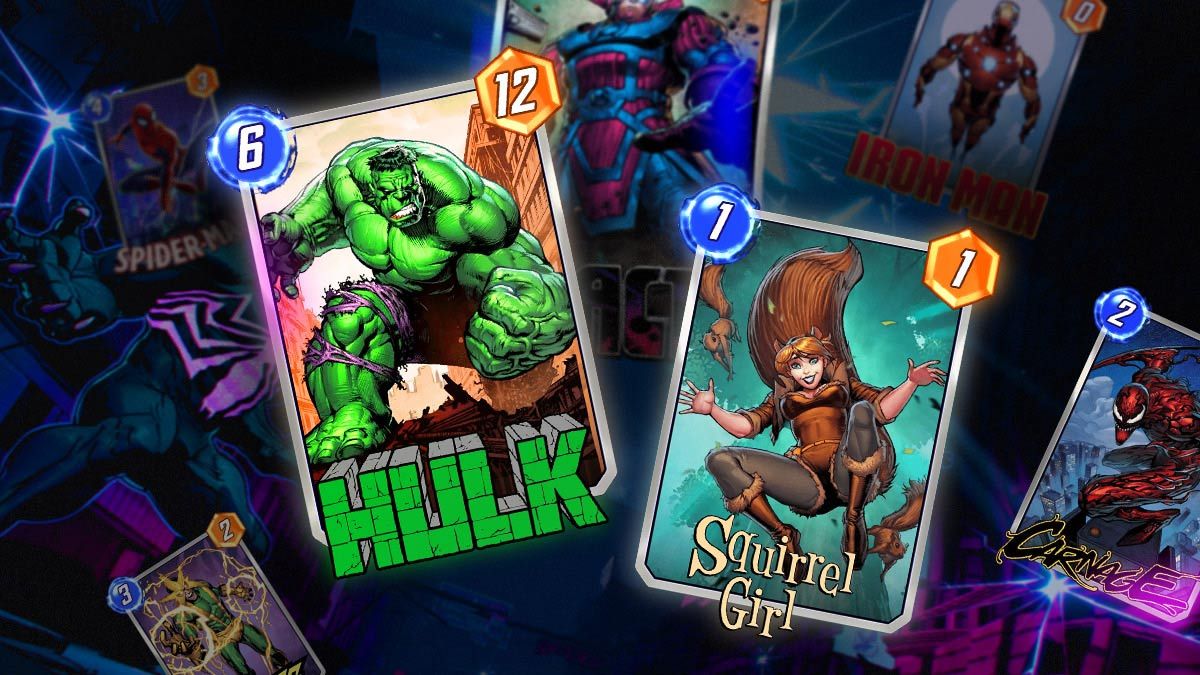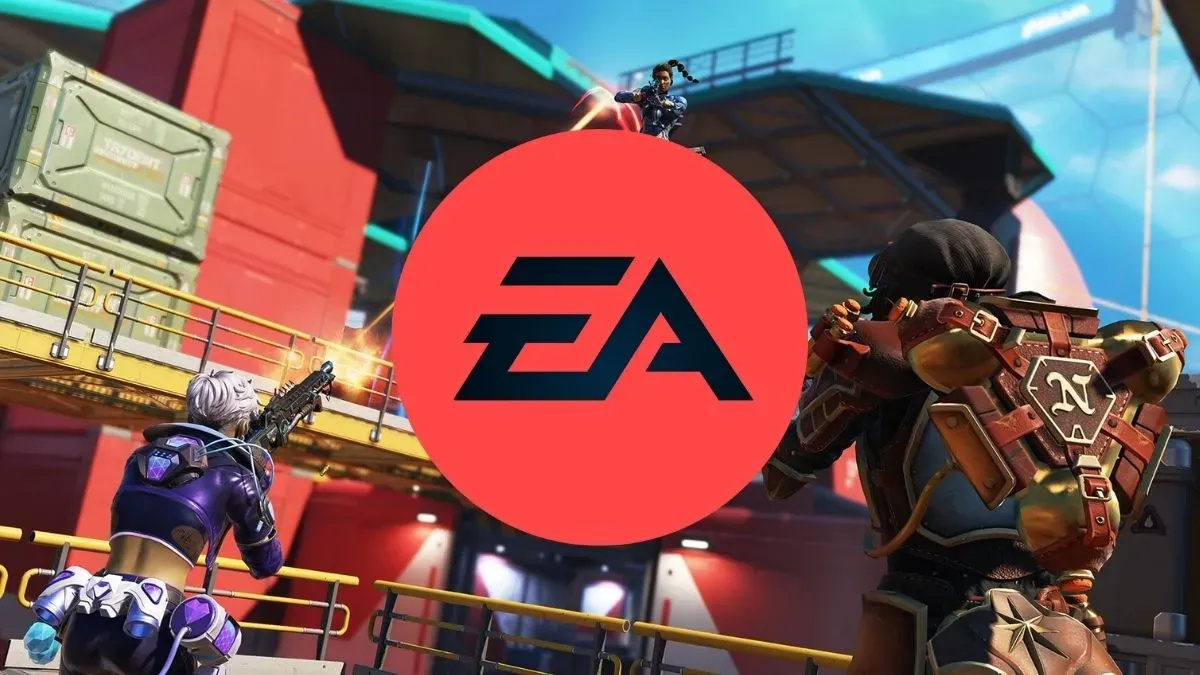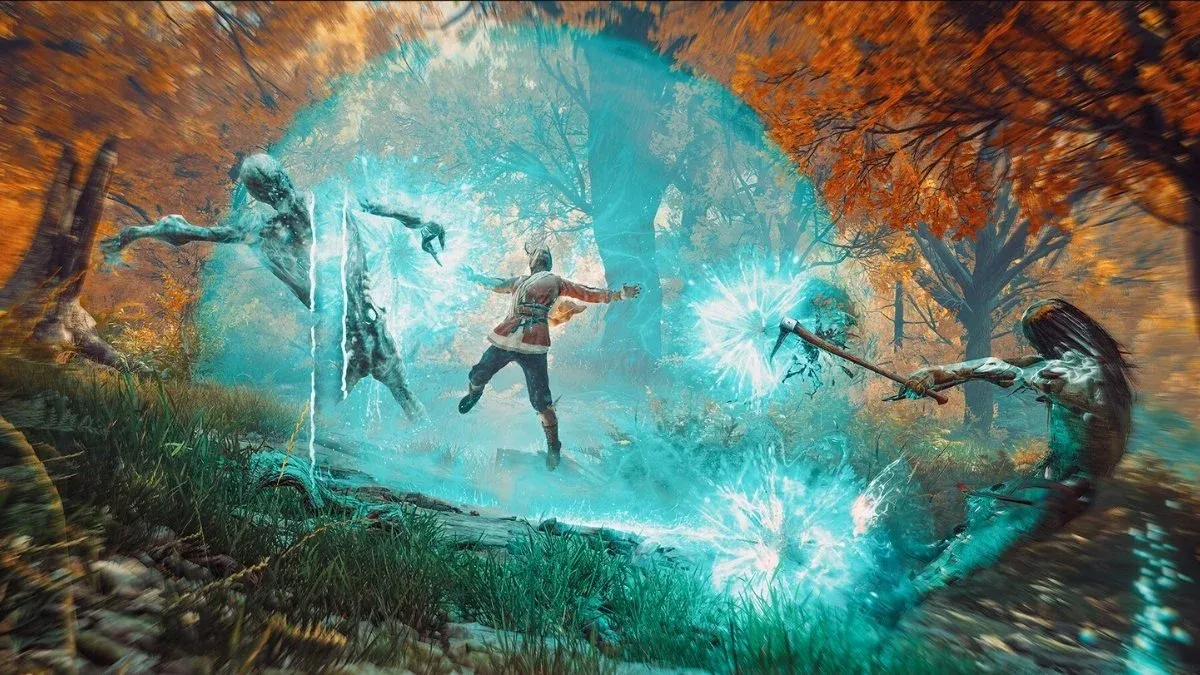We’ve got a few tips and tricks to give you an early head start in Marvel Snap, the new mobile card game that has us hooked.
It’s funny how much you can learn about a game after just a week of non-stop playing. My first few days in Marvel Snap were clumsy at best. I spent a lot of time upgrading cards with wanton disregard of the credits I was running out of, only played cards with my favourite characters and paid zero attention to completing weekly and seasonal missions. In other words, I made every mistake in the book while starting out in Marvel’s new digital deck builder game - and I’m here to stop you from making them too.
Marvel Snap is a fun and extremely addictive experience, but there are a few ways to get ahead early before the competition starts to heat up at higher ranks. Whether you’re looking for the best starter decks to play or just trying to figure out the basics, here’s everything a beginner needs to know about Marvel Snap.
The fundamentals
Compared to other virtual card games like Hearthstone and Magic the Gathering Arena, Marvel Snap’s gameplay loop is downright simple to get the hang of. Its three-minute long matches make the game as easy to pick up as it is to put down, but no less enthralling to play so long as you’ve got your basics covered. Each player can build a deck of 12 cards to bring into a match, with each card portraying a Marvel Comics character that comes with an Energy cost, a Power level and in most cases, a special ability. Seeing as the game has more than 200 cards for you to collect, you can imagine the amount of deck building combinations available here.
A match gets assigned three random locations, each of which have special effects that are revealed over the first three turns. For example, the Bifrost moves all cards one location to the right after Turn 4. Each game has six turns, but the Limbo location could suddenly throw a seventh turn at you and upend all your well-made plans. That’s the thing about Marvel Snap: you could build the perfect deck, but even if luck is on your side and the opponent hasn’t brought in a deck that counters yours, locations could always end up being your undoing. They could also be your salvation however, and therein lies the fun.
The player is given one more energy point each turn to play cards with higher energy costs, and cards with higher energy costs typically come with higher Power levels. This leads to a natural power curve that ramps up over time, culminating in the sixth turn where the most powerful cards finally get their due. The goal is to get the highest Power level in two out of three locations, meaning that the total Power of your cards outnumbers your opponent in a location. There is also a ranked system, where you earn ‘Cubes’ after each win, and ten Cubes raises your ranked level by one. You can also double the amount of Cubes won from a game by ‘snapping’ during any turn, and you can keep snapping as long as you’re confident that you’re going to win.
All in all, it took me just a few matches to pick these rules up. Marvel Snap does a pretty good job at welcoming new players into the fold, and it isn’t hard to catch up even if you’re getting into the game today. I didn’t start playing until quite some time after launch, and found myself breezing through the competition during the early days. Even if you’re not playing to win games, there are loads of ways to feel like you’re still progressing in Marvel Snap. Each time you finish a daily mission, you get Credits to spend on upgrading cards and Season XP that goes to the Battle Pass. When you upgrade cards, you gain Collection Levels and earn new cards. When you level the Battle Pass, you get more credits and card variants. You’re always playing for something in Marvel Snap.
How do I get new cards?

Upgrade cards to get cards! After every match, you'll get Boosters that allow you to upgrade the rarity of a specific card. When you upgrade a card, you gain Collection Levels. Every few Collection Levels, the game gives you a random mystery card, growing your collection and giving you access to new decks. Upgrading cards costs Credits, and you'll find that they can get quite expensive to upgrade at higher rarities. It's a lot more efficient to spend your credits on upgrading cards from Common to Uncommon and Rare, because otherwise you run out of Credits faster than you can use them.
It should be noted that Collection Levels give you cards from different 'series' depending on how far ahead you are. Series 1 goes from Collection Level 18 to 214, giving you 46 cards in total. Series 2 goes from Level 222 to Level 474, giving 25 cards in total. Series 3 starts from Level 486 onwards with 74 cards in total and more on the way. You'll gain access to better and more powerful cards at the higher Series, but there's plenty to work with in Series 1 too.
A few good starter decks to try out
/cdn.vox-cdn.com/uploads/chorus_asset/file/24124186/PC_DARK_KA2_HORIZ_DIGITAL_FINAL_SIMPLE_BLEED_09.22.2022.jpg)
Now that we’ve covered the basics, let’s jump into some of the best decks you can start out with. Marvel Snap hands out new cards randomly, which means that everyone starts out playing with access to different decks. If you don’t like the cards you’ve started out with, just keep playing and you’ll find at least a few more that can make up a solid deck. The best decks build synergy around a specific ability, which is why there really isn't a ‘best’ or ‘worst’ card to use here. The usefulness of a card depends on the way a deck is built around it. For example, meet my favourite starter deck, lovingly named ‘Kazoo’ by the Marvelsnap.io community:
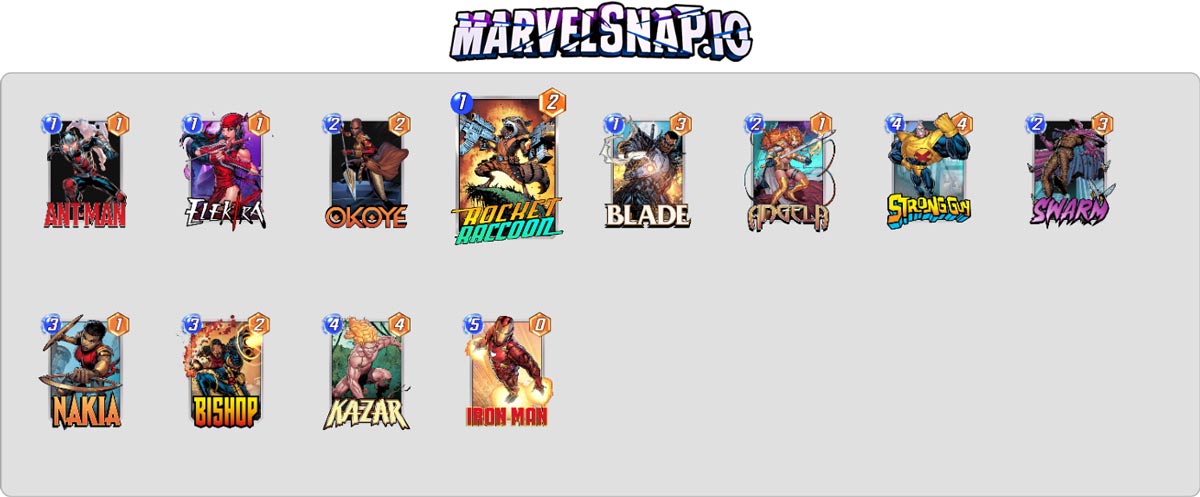
The Kazoo deck gets its name from Kazar, a card that gives all 1-Cost cards +1 Power. Above, you'll see Cost numbers in blue and Power numbers in orange. The strategy is to build a deck filled with useful 1-Cost cards that get boosted by Kazar, and then add in a few more powerful cards like Iron Man to guarantee a location win on the sixth turn. 1-Cost cards are shockingly useful here, and this deck is very flexible. I’ve fiddled with it multiple times after gaining new cards, and it’s constantly held strong no matter what I threw at it. Don’t worry about copying the deck above exactly - just fill in the gaps with the closest substitutes you’ve got on hand.
Next, meet my good pal Odin:
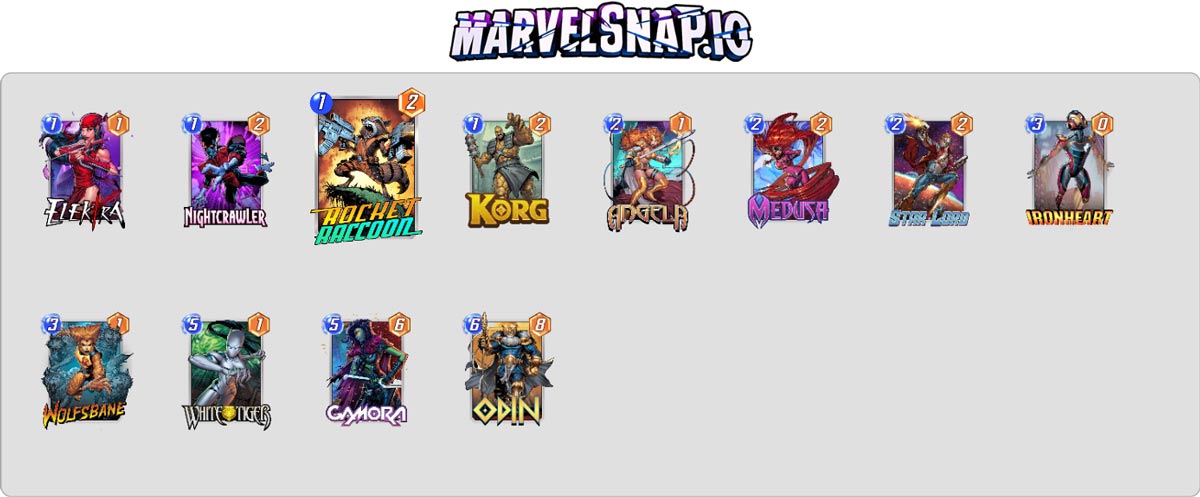
Marvel Snap has a few really good On Reveal cards, but as the name suggests, their abilities are only activated once: when they're played. Odin says that rule is nonsense, and re-activates all other On Reveal cards at his location the moment he’s played. Pair him with a few useful On Reveal cards like White Tiger, who spawns a 7-Power Tiger in another location, or Ironheart, who gives three other cards +2 Power for big combos!
What’s that? You don’t have any of these cards yet? How about this very simple starter deck then, played by game designer Ben Brode himself during one of the game’s first reveal streams:
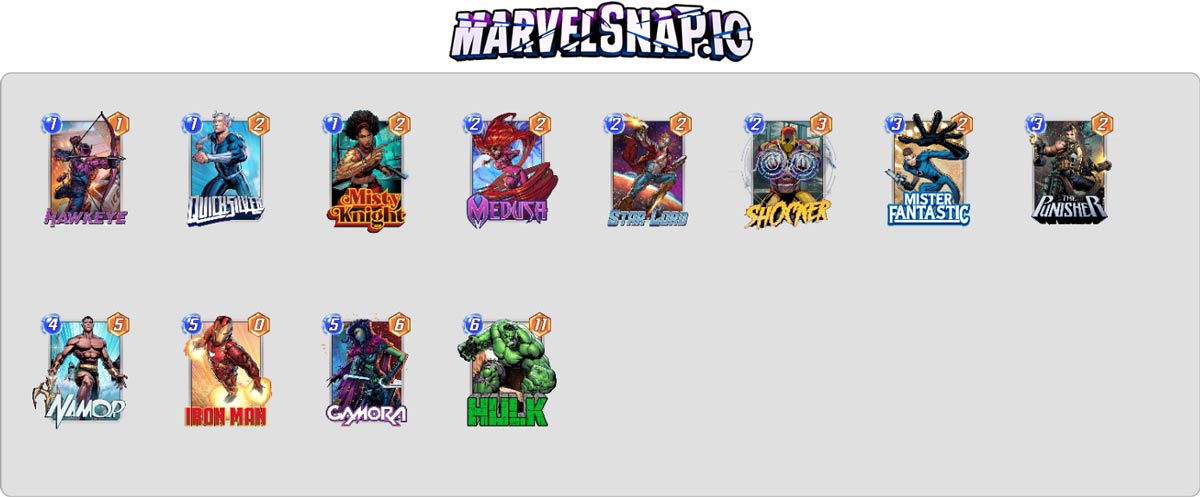
This one is just a collection of great cards that, if played right, should get you a win with little trouble. Play Medusa in the middle location if possible to double her Power, and Mister Fantastic to add +2 Power to adjacent locations. After that, you just do your best to counter your opponent and throw in the Hulk as a last-turn location-winner!
These three decks play with some basic card ability types, like ‘On Reveal’ and ‘Ongoing’ to build huge combos that pay off in the lategame. As you progress and gain access to higher tier cards, you’ll be able to build strong decks around card mechanics like ‘Destroy’ and ‘Move’, which can be really fun if a bit riskier. It’s all about having fun, and personally, I love the gameplay variety that comes with building all sorts of decks that play with vastly different cards. Playing a Kazoo deck can get old after the first 50 matches, so don’t be afraid to experiment and see what works.

